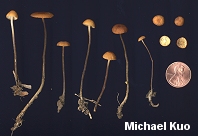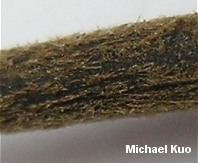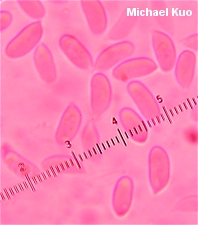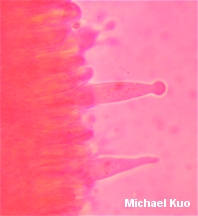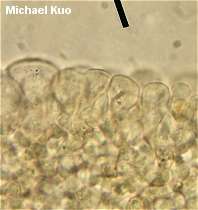| Major Groups > Gilled Mushrooms > Pale-Spored > Marasmioid > Rhizomarasmius pyrrhocephalus |

|
Rhizomarasmius pyrrhocephalus [ Basidiomycetes > Agaricales > Physalacriaceae > Rhizomarasmius . . . ] by Michael Kuo This little marasmioid mushroom-like mushroom can almost be recognized without a microscope, if you are willing to subject it to intense scrutiny. Look for a combination of features: the orange to orangish brown cap; the tough stem that is dark brown or black, densely hairy, and usually deeply rooted and elongated; the white spore print; and the absence of a distinctive odor or taste. Microscopic characters (see below) will confirm identification. Like a Chicago voter, Rhizomarasmius pyrrhocephalus shows up at the polls early and often; it is "one of the first agarics to appear in the spring and one of the last to cease fruiting in the fall" (Gilliam, 1975). Older sources treat this mushroom as a species of Marasmius, but DNA results (Moncalvo and collaborators, 2002) have upheld the suggestion of Petersen (2000) that it deserves separate treatment. Marasmius pyrrhocephalus, Marasmius longipes, and Marasmius elongatipes are synonyms. Marasmius sullivantii has a smooth stem that is usually paler in color and more fragile; its pileipellis has broom cells. Description: Ecology: Saprobic on leaf litter and woody debris in hardwood forests (especially oak-hickory woods); growing alone or gregariously; spring, summer, and fall; widely distributed east of the Rocky Mountains. Cap: Up to 2.5 cm across; convex, becoming broadly convex or nearly flat; smooth or finely wrinkled; the margin often slightly lined; orange to yellowish orange, darkening with age to brownish orange or nearly brown. Gills: Attached to the stem; close or nearly distant; whitish, becoming dingy or yellowish; sometimes developing brownish spots or discolorations. Stem: 3-10 cm long; up to 2 mm thick; usually deeply rooted (up to 5 cm); more or less equal; dry; tough; densely velvety or hairy; dark reddish brown, brown, or nearly black (but paler initially and sometimes pale near the apex in age). Flesh: Insubstantial; pale. Odor and Taste: Taste not distinctive, or with a slightly bitter aftertaste; odor not distinctive. Chemical Reactions: KOH negative on cap surface. Spore Print: White. Microscopic Features: Spores 6-10 x 3-4 µ; smooth; elliptical; inamyloid. Pleuro- and cheilocystidia variously shaped but often fusiform or capitate; 30-70 µ long. Pileipellis a hymeniform layer of variously shaped, smooth cells measuring 8-24 x 4-24 µ; inamyloid or with dextrinoid granular contents. REFERENCES: Berkeley, 1847. (Kauffman, 1918; Gilliam, 1975; Petersen, 2000; Roody, 2003.) Herb. Kuo 04309501, 05260303, 06100302, 05030405, 05031102. This site contains no information about the edibility or toxicity of mushrooms. |
© MushroomExpert.Com |
|
Cite this page as: Kuo, M. (2008, May). Rhizomarasmius pyrrhocephalus. Retrieved from the MushroomExpert.Com Web site: http://www.mushroomexpert.com/rhizomarasmius_pyrrhocephalus.html |
